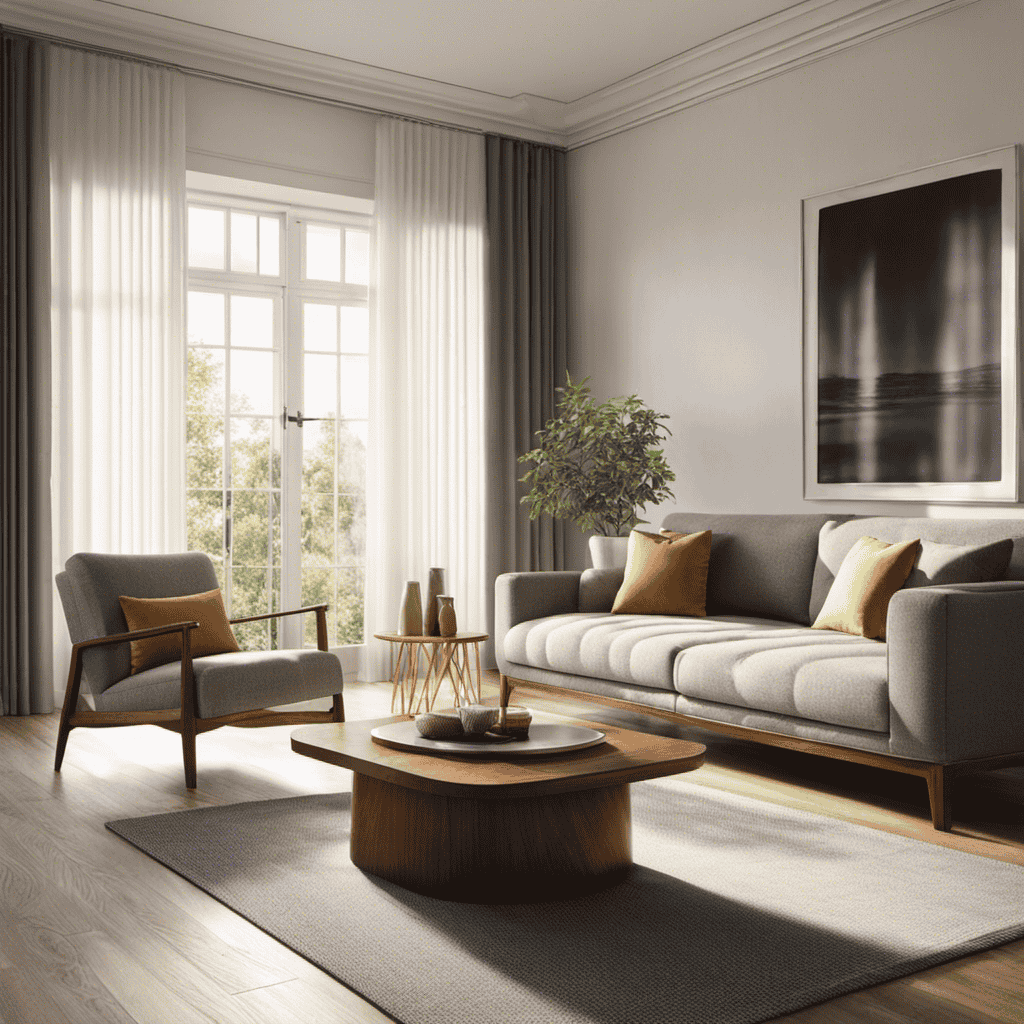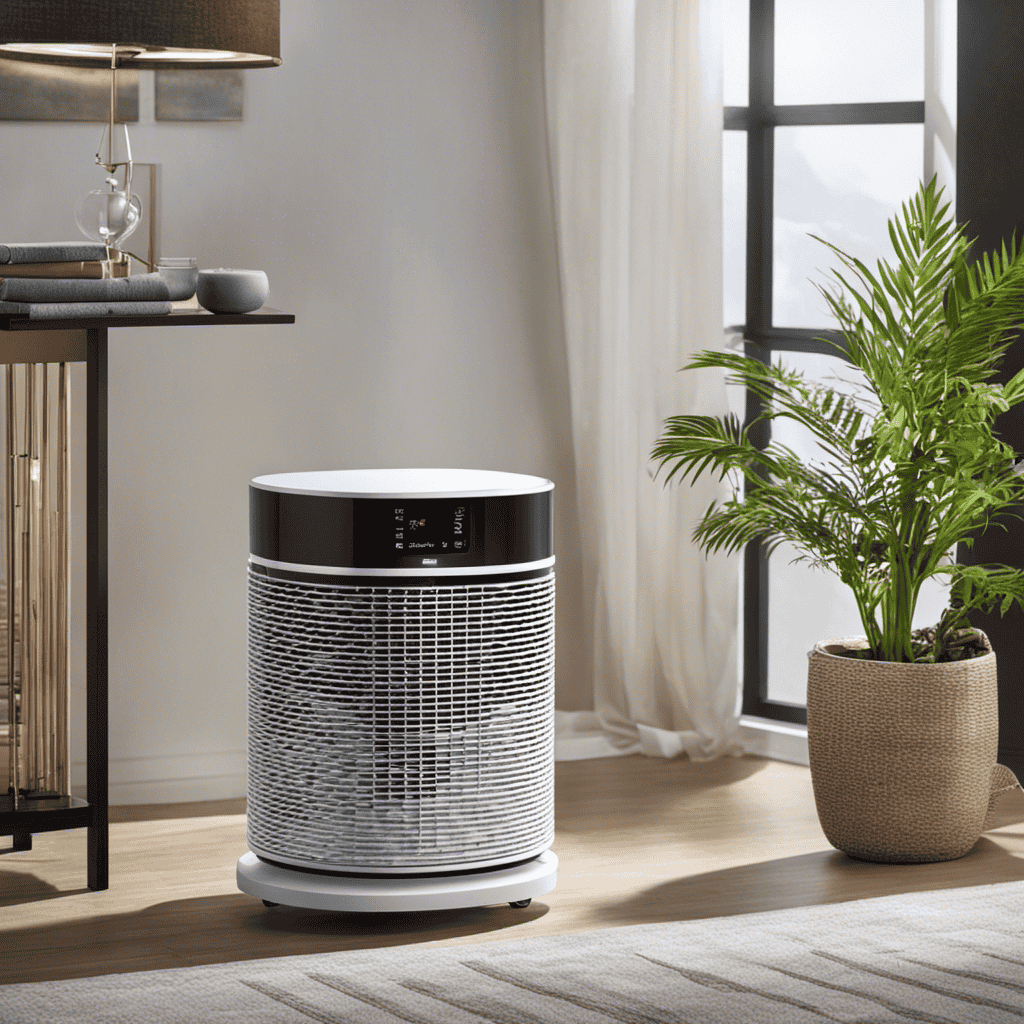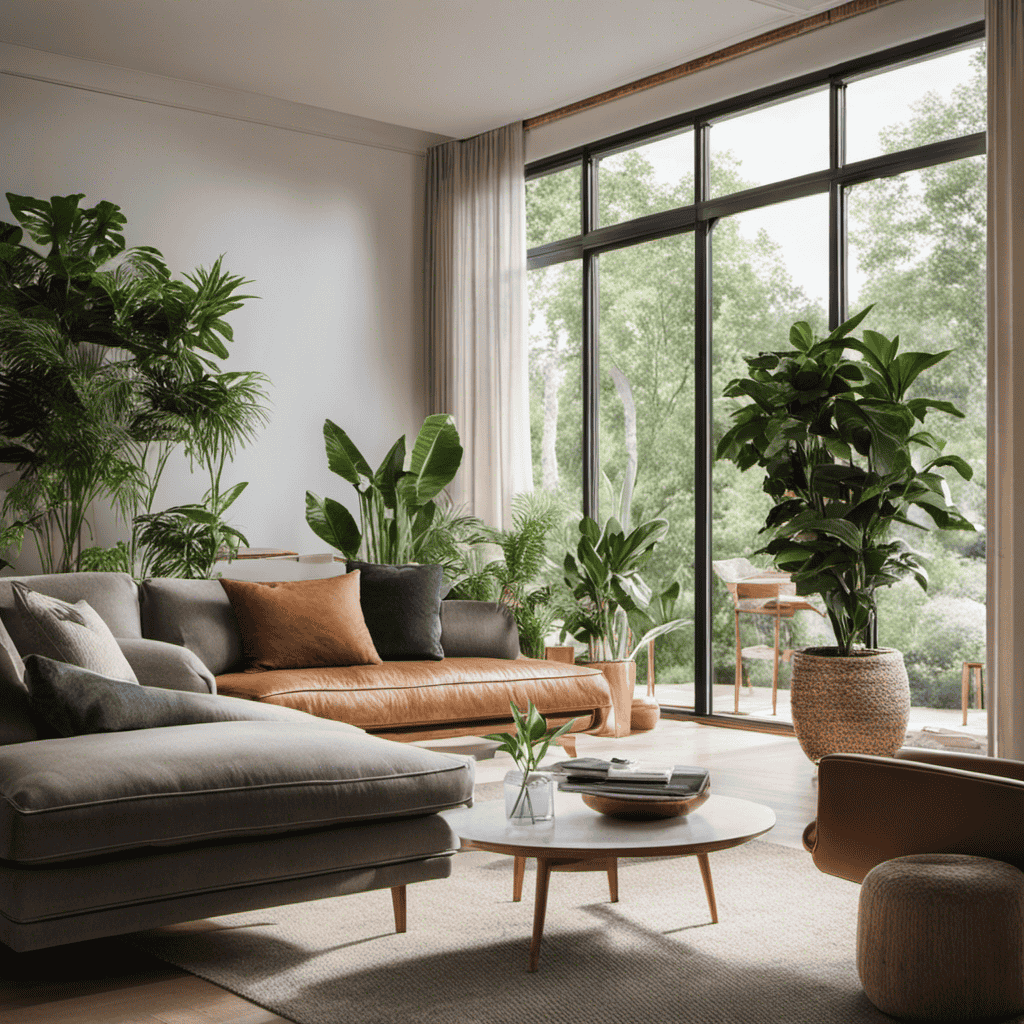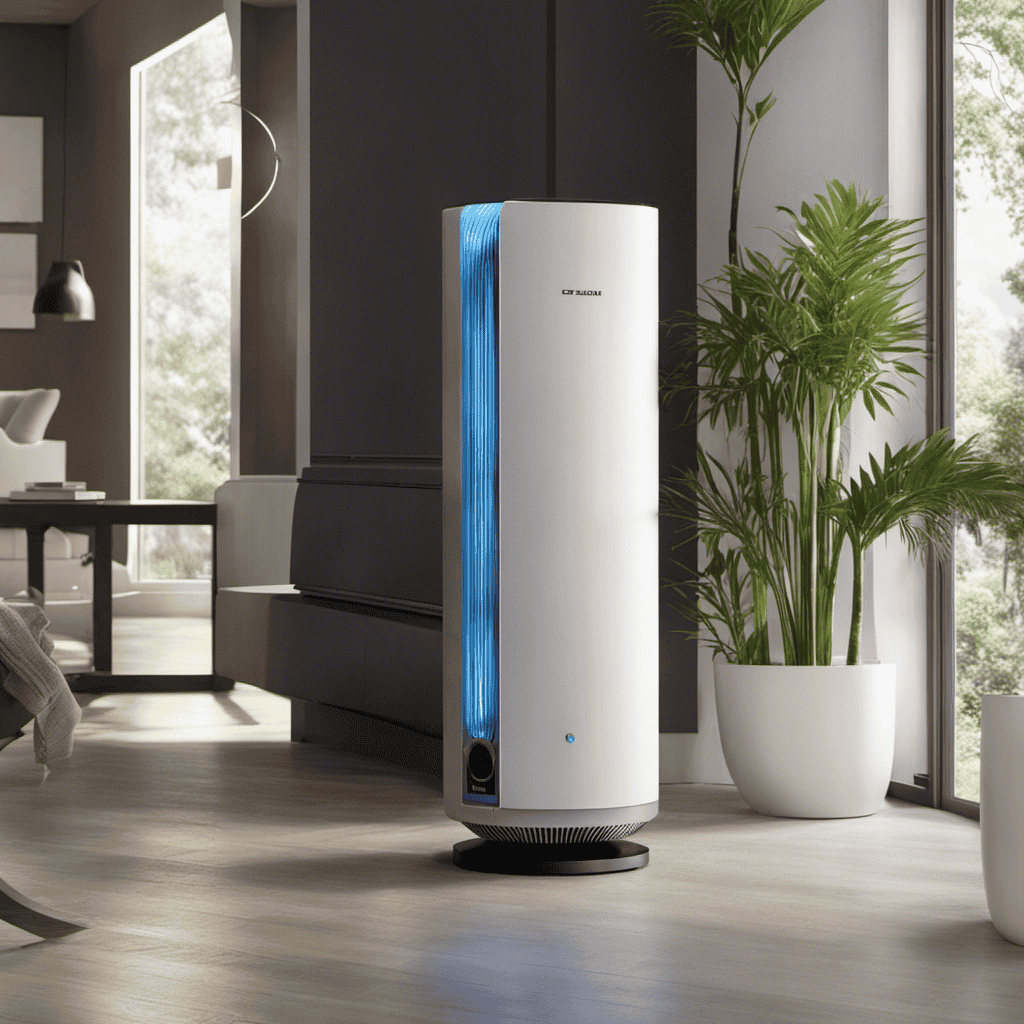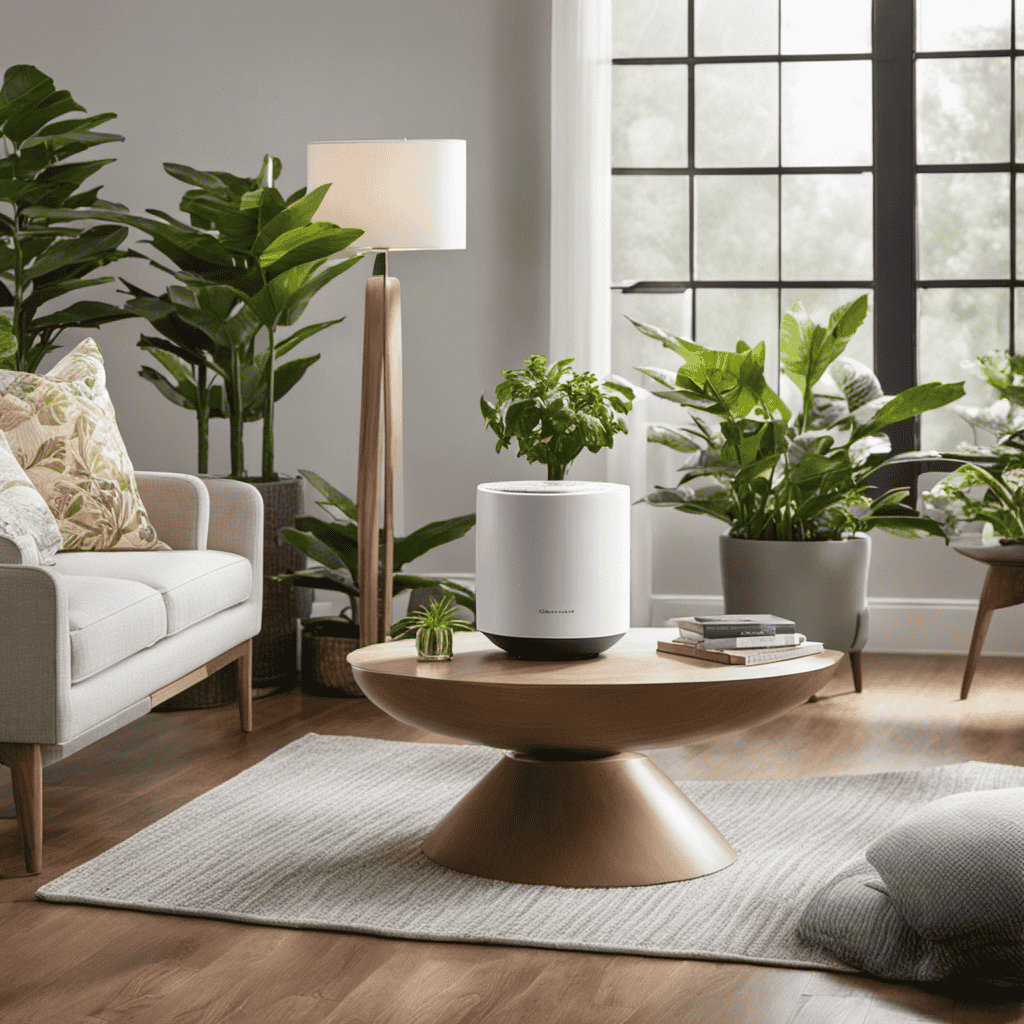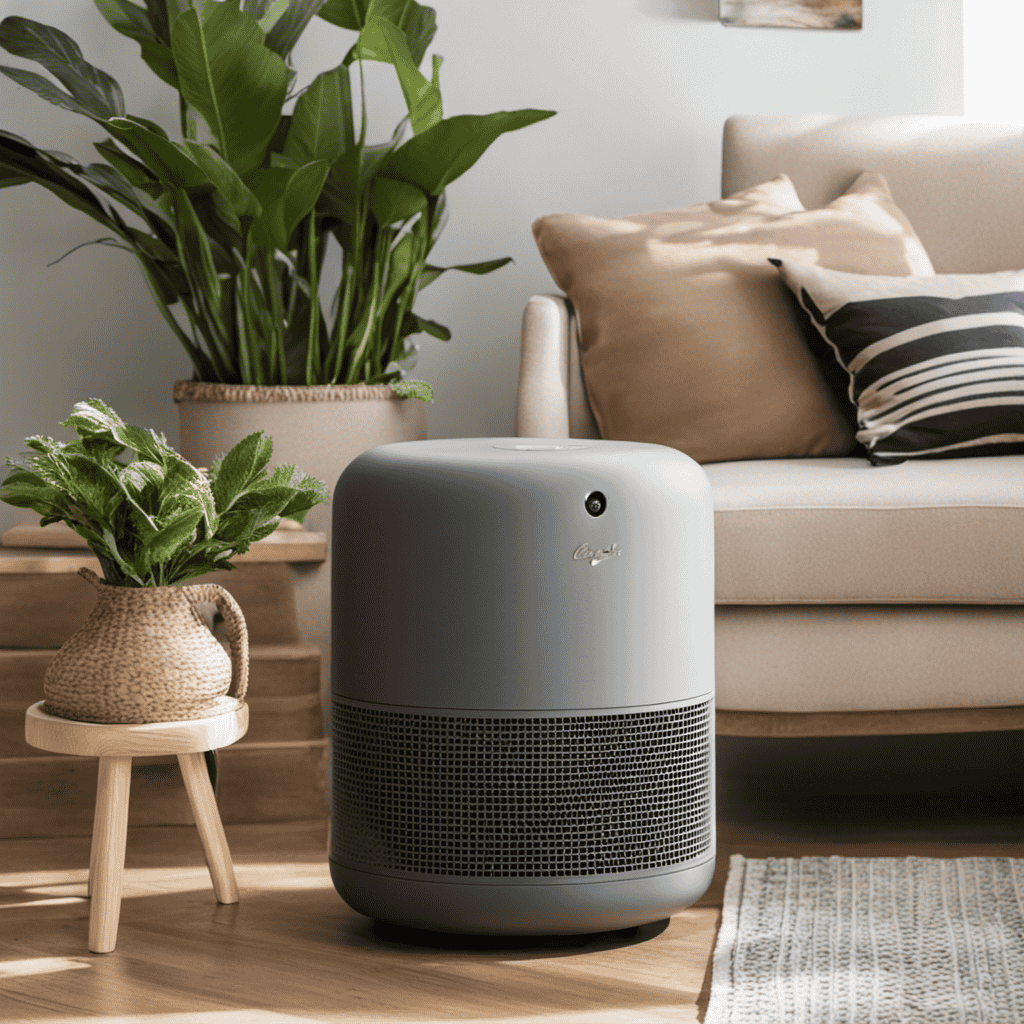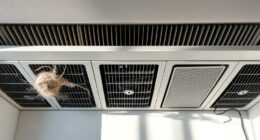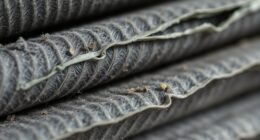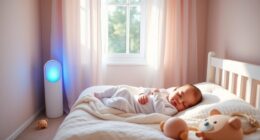As a person who appreciates clean and fresh air, I have frequently pondered, ‘What exactly does an air purifier accomplish?’ It is truly remarkable how this compact but mighty device can enhance the air quality we inhale.
In this article, we will explore the benefits of using an air purifier, how it works, and the types of pollutants it can remove. By understanding the role of air purifiers in creating a healthy home environment, we can make informed decisions to enhance our well-being.
Key Takeaways
- Air purifiers remove harmful pollutants and allergens from the air, improving respiratory health and providing allergy relief.
- They eliminate unpleasant odors, such as smoke or cooking smells, creating a cleaner and fresher living space.
- Air purifiers reduce the risk of airborne diseases by trapping and killing bacteria and viruses.
- They use physical and chemical filters, including activated carbon filters, to capture particles and remove volatile organic compounds (VOCs) from the air.
Benefits of Using an Air Purifier
Using an air purifier can greatly improve the quality of the air I breathe. The benefits of using an air purifier are numerous and significant.
First and foremost, an air purifier helps to remove harmful pollutants and allergens from the air, such as dust, pollen, pet dander, and mold spores. This is especially beneficial for individuals with allergies, asthma, or other respiratory conditions.
Additionally, air purifiers can help to eliminate unpleasant odors, such as smoke or cooking smells, creating a fresher and more pleasant environment.
Moreover, air purifiers can also reduce the risk of airborne diseases by trapping and killing bacteria and viruses.
Overall, the advantages of using an air purifier include improved respiratory health, allergy relief, odor elimination, and a cleaner and healthier living space.
How Does an Air Purifier Work
To understand how an air purifier works, you can think of it as a device that filters and cleans the air in your home. Here’s how it does it:
- Air purifiers use a combination of physical and chemical filters to trap airborne particles such as dust, pollen, pet dander, and mold spores.
- The filters in the purifier capture these particles as air passes through, preventing them from circulating in your home.
- Some air purifiers also use activated carbon filters to remove odors and chemicals from the air.
- By removing these particles and pollutants, air purifiers improve respiratory health by reducing exposure to allergens and irritants.
- Regular use of an air purifier can lead to fewer allergy symptoms, improved sleep quality, and a healthier indoor environment.
Understanding how air purifiers work is essential to realizing their benefits. Now, let’s explore the different types of air pollutants that air purifiers can remove.
Types of Air Pollutants Removed by Air Purifiers
Air purifiers help improve indoor air quality by effectively trapping and removing various types of airborne pollutants. These devices utilize different removal techniques to target specific pollutants, ensuring a thorough purification process.
Particulate matter, such as dust, pollen, and pet dander, is captured using filters with various levels of efficiency. Volatile organic compounds (VOCs), which are emitted from household products and furnishings, are adsorbed by activated carbon filters.
Some air purifiers also employ ultraviolet (UV) light technology to neutralize bacteria and viruses. By utilizing these removal techniques, air purifiers can significantly reduce the concentration of pollutants in indoor spaces, leading to improved indoor air quality.
Now, let’s explore the common features of air purifiers and how they contribute to their effectiveness.
Common Features of Air Purifiers
One common feature of air purifiers is the presence of filters that capture and remove various types of pollutants from indoor spaces. These filters play a crucial role in improving indoor air quality by trapping particles such as dust, pollen, pet dander, and smoke.
In addition to filters, air purifiers may also have other common features including:
- Multiple fan speeds to adjust the airflow according to the room size and pollution levels.
- Indicator lights or sensors that provide real-time feedback on air quality.
- Timer settings to automatically turn on or off the purifier at specified times.
- Quiet operation mode for undisturbed sleep or work.
- Child lock feature to prevent accidental changes in settings.
When choosing an air purifier, it is important to consider the optimal size for the room you intend to use it in. A purifier that is too small may not effectively clean the air, while one that is too large may be unnecessarily expensive and consume more energy.
Health Effects of Poor Air Quality
Poor air quality can have detrimental effects on our health, causing respiratory issues, allergies, and even increasing the risk of cardiovascular diseases. Breathing in polluted air can lead to inflammation in the airways, which can trigger asthma attacks and worsen chronic respiratory conditions. Additionally, exposure to air pollution can irritate the respiratory system, leading to coughing, wheezing, and shortness of breath. Long-term exposure to air pollution has been linked to the development of respiratory diseases such as chronic obstructive pulmonary disease (COPD) and lung cancer. It is important to protect our respiratory health by minimizing exposure to air pollution and taking measures such as using air purifiers to filter out harmful pollutants.
| Air Pollution Effects | Respiratory Health | Cardiovascular Diseases |
|---|---|---|
| Inflammation of airways | Asthma attacks | Increased risk |
| Irritation of lungs | Chronic respiratory conditions | of heart disease |
| Development of respiratory diseases | Shortness of breath |
How Air Purifiers Improve Indoor Air Quality
To improve indoor air quality, you can consider using an air purifier. Air purifiers are beneficial for several reasons:
-
Removes airborne pollutants: Air purifiers can filter out pollutants such as dust, pollen, pet dander, and mold spores, improving the overall air quality in your home.
-
Reduces odors: Air purifiers can eliminate unpleasant odors caused by cooking, pets, or smoke, leaving your indoor space smelling fresh and clean.
-
Decreases allergy and asthma symptoms: By removing allergens from the air, air purifiers can help reduce allergy and asthma symptoms, providing relief for those who suffer from these conditions.
-
Improves respiratory health: Clean air promotes better respiratory health, reducing the risk of respiratory infections and improving lung function.
-
Enhances sleep quality: With cleaner air, you can breathe easier and experience better sleep quality, leading to improved overall well-being.
Choosing the Right Size Air Purifier for Your Space
When it comes to choosing the right size air purifier for your space, it’s important to consider the space requirements for the purifier and find the optimal purifier size.
The space requirements for a purifier depend on the size of the room, the level of air pollution, and the specific needs of the occupants.
To determine the optimal purifier size, factors such as the Clean Air Delivery Rate (CADR) and the Air Changes per Hour (ACH) should be taken into account.
Space Requirements for Purifier
The air purifier needs enough space to effectively circulate and clean the air. Proper placement of your purifier is essential to ensure optimal performance. Here are some key factors to consider:
-
Room size: Use a purifier size calculator to determine the appropriate purifier size for your room. This will help you choose a purifier that can effectively clean the air in your space.
-
Airflow: Place the purifier in an area where it can freely circulate the air. Avoid placing it in a corner or against a wall, as this can restrict airflow.
-
Distance from walls: Maintain a distance of at least a foot between the purifier and walls or furniture. This allows for better air intake and distribution.
-
Avoid obstructions: Keep the purifier away from objects that could block or disrupt the airflow, such as curtains, furniture, or plants.
-
Central location: Position the purifier in a central location within the room to ensure even distribution of clean air throughout the space.
Optimal Purifier Size
Now that we understand the space requirements for an air purifier, let’s discuss the optimal purifier size for maximum performance. Choosing the right size purifier is crucial to ensure effective air filtration in your specific space.
To help you determine the optimal purifier size, I have provided a table below that suggests the recommended purifier size based on room dimensions:
| Room Size | Purifier Size (CADR*) |
|---|---|
| Small (up to 300 sq. ft.) | 100-150 CADR |
| Medium (300-600 sq. ft.) | 150-300 CADR |
| Large (600-900 sq. ft.) | 300-450 CADR |
*CADR: Clean Air Delivery Rate
Placing the purifier in the right location is equally important. It is recommended to place the purifier in an area where it can efficiently circulate the air, such as the center of the room or near the source of pollution. Avoid placing the purifier directly against walls or furniture, as it may restrict airflow and reduce its effectiveness. By considering both the optimal purifier size and proper placement, you can ensure that your air purifier performs at its best, providing you with clean and healthy indoor air.
Maintenance and Cleaning Tips for Air Purifiers
Regular maintenance is crucial for keeping your air purifier running efficiently. Neglecting maintenance can lead to decreased performance and potential health risks. Here are some essential maintenance tips and cleaning techniques to ensure your air purifier is functioning optimally:
- Change the filters regularly to remove dust, allergens, and pollutants.
- Clean the exterior of the air purifier with a soft cloth or brush to remove any dust or debris.
- Vacuum or wipe down the pre-filter to remove larger particles.
- Check the manufacturer’s instructions for specific cleaning recommendations.
- Keep the air purifier in a well-ventilated area and away from obstructions.
By following these maintenance tips and cleaning techniques, you can ensure that your air purifier continues to provide clean and fresh air for your space.
Now let’s delve into understanding air purifier filters and their importance in the next section.
Understanding Air Purifier Filters
Understanding how air purifier filters work is essential for maintaining the efficiency of your device. When it comes to air purifier maintenance, the filters play a crucial role in capturing and removing airborne pollutants from your indoor environment.
There are different types of air purifier filters available, each with its own unique features and capabilities. The most common types include HEPA filters, activated carbon filters, and electrostatic filters. HEPA filters are highly effective at capturing particles as small as 0.3 microns, while activated carbon filters excel at removing odors and chemicals. Electrostatic filters use an electric charge to attract and trap particles.
When comparing air purifier filters, consider factors such as the filter lifespan, replacement costs, and the specific pollutants you want to target. By regularly cleaning or replacing your air purifier filters, you can ensure that your device continues to provide clean and fresh air.
Now, let’s explore whether air purifiers can effectively remove odors.
Do Air Purifiers Remove Odors
When it comes to air purifiers, one important aspect to consider is their effectiveness in eliminating odors. Different air purifiers have varying degrees of odor elimination effectiveness, depending on their filtration systems and technologies.
It is crucial to understand the types of odors that an air purifier can tackle, such as pet odors, cooking smells, or smoke, as this will determine the suitability of the device for your specific needs.
Additionally, long-term odor control is a significant factor to consider, as some air purifiers may temporarily mask odors rather than providing a lasting solution.
Odor Elimination Effectiveness
To truly eliminate odors in your home, you’ll want to consider how effective an air purifier can be. With advanced technology and innovative design, air purifiers are highly effective in removing odors and improving indoor air quality. Here are some reasons why air purifiers are so effective in eliminating odors:
-
HEPA Filters: Air purifiers equipped with HEPA filters can capture and trap microscopic particles, including odor-causing molecules.
-
Activated Carbon Filters: These filters are specifically designed to absorb and neutralize odors, leaving your home smelling fresh.
-
UV-C Light Technology: Some air purifiers use UV-C light to kill bacteria and viruses, which can contribute to unpleasant odors.
-
Ozone Generation: Ozone generators can neutralize strong odors by breaking down the molecules responsible for the smell.
-
Multiple Filtration Stages: Air purifiers with multiple filtration stages can effectively remove a wide range of odors, from pet smells to cooking odors.
With these odor removal techniques, air purifiers provide a practical and scientific solution to eliminate odors in your home. Now, let’s explore the different types of odors and how air purifiers can target them specifically.
Types of Odors
Now that we’ve covered the effectiveness of air purifiers in eliminating odors, let’s delve into the different types of odors you may encounter in your home. Odors can come from various sources, ranging from food to pets to household products. Understanding the types of smells can help you choose the right air purifier for your specific needs.
Here is a table that outlines some common types of smells and their sources:
| Type of Smell | Source |
|---|---|
| Food Odors | Cooking, Rotting |
| Pet Odors | Urine, Dander |
| Smoke Odors | Cigarettes, Fire |
| Mold and Mildew | Dampness, Decay |
| Chemical Odors | Cleaning Agents |
Long-Term Odor Control
If you want long-term odor control, it’s important to address the root cause of the smells in your home. Simply masking the odors with air fresheners or candles will only provide temporary relief.
To effectively eliminate odors and maintain a fresh-smelling environment, consider the benefits of air purification:
- Air purifiers remove airborne particles that contribute to unpleasant odors, such as pet dander, dust, and pollen.
- They neutralize odors at the molecular level by capturing and trapping odor-causing molecules.
- Some air purifiers are equipped with activated carbon filters that effectively absorb and eliminate strong odors, like those from cooking or smoking.
- Air purifiers with ozone generators can break down and eliminate stubborn odors, such as those from mold or mildew.
- By improving indoor air quality, air purifiers can help prevent the buildup of odors and create a healthier living environment.
Investing in a high-quality air purifier can provide long-term odor control and improve the overall freshness of your home.
Air Purifiers Vs. Humidifiers: What’s the Difference
Air purifiers and humidifiers serve different purposes in improving indoor air quality. While air purifiers focus on removing airborne pollutants such as dust, pet dander, and allergens, humidifiers add moisture to the air to combat dryness. Let’s compare the two in a table:
| Air Purifiers | Humidifiers |
|---|---|
| Removes airborne pollutants | Adds moisture to the air |
| Improves respiratory health | Prevents dry skin and allergies |
| Filters out dust, pollen, and pet dander | Reduces static electricity |
| Helps with asthma and allergies | Prevents wood furniture from cracking |
Air purifiers are particularly beneficial for respiratory health, as they effectively filter out harmful particles that can trigger asthma or allergies. On the other hand, humidifiers can alleviate dry skin and prevent allergies caused by excessively dry air. Both devices play important roles in maintaining a healthy indoor environment, but it’s crucial to choose the right one for your specific needs.
Can Air Purifiers Help With Allergies
You might be wondering how air purifiers can help alleviate allergies. Well, let me explain.
Air purifiers are designed to remove airborne particles, such as pollen, dust mites, pet dander, and mold spores, from the air. By reducing these allergens, air purifiers can provide relief for those suffering from respiratory conditions and seasonal allergies.
Here are five reasons why air purifiers are beneficial for allergies:
- Air purifiers capture and trap allergens, preventing them from circulating in the air.
- They help create a clean and healthy indoor environment, reducing exposure to allergens.
- Air purifiers can improve air quality by removing pollutants, such as smoke and chemical fumes, which can trigger allergies.
- They can provide relief from symptoms like sneezing, coughing, and itchy eyes.
- Air purifiers are a non-invasive and drug-free solution for allergy relief.
Air Purifiers for Asthma Relief
Asthma sufferers can find relief by using air purifiers designed specifically for respiratory conditions. These devices work by filtering out airborne particles such as dust, pollen, pet dander, and mold spores, which are common triggers for asthma attacks.
By removing these irritants from the air, air purifiers can help improve the overall air quality in the bedroom, leading to better sleep quality for individuals with asthma.
Additionally, air purifiers can also be effective in reducing the risk of respiratory illnesses in asthma patients. By eliminating harmful pollutants from the air, these devices can help prevent the onset of respiratory infections, which can further aggravate asthma symptoms.
Therefore, incorporating air purifiers into the bedroom can provide significant benefits for individuals with asthma, improving both their sleep quality and overall respiratory health.
Air Purifiers for Pet Owners
As someone who suffers from asthma, I understand the importance of clean air in maintaining good respiratory health. In my quest for finding the best air purifier, I discovered that they can also be incredibly beneficial for pet owners.
Pets, while adorable, can be a source of allergens such as pet dander, which can trigger allergies and respiratory issues. Air purifiers designed for pet owners can help reduce these allergens, creating a healthier environment for both humans and pets.
Here are some key benefits of using air purifiers for pet owners:
- Removes pet dander from the air
- Filters out pet hair and fur
- Eliminates pet odors
- Reduces airborne pet allergens
- Improves overall indoor air quality
Investing in an air purifier specifically designed for pet dander control can greatly alleviate pet allergies and create a more comfortable living space for everyone in the household.
The Role of Air Purifiers in Creating a Healthy Home Environment
If you’re looking to create a healthy home environment, it’s important to consider the role of air purifiers. These devices play a crucial role in maintaining clean air, which has numerous benefits for our overall well-being, especially when it comes to respiratory health. Clean air can significantly reduce the risk of respiratory illnesses and allergies, as it filters out pollutants and allergens from the environment. To emphasize the importance of clean air and its impact on respiratory health, let’s take a look at the following table:
| Benefits of Clean Air | Impact on Respiratory Health |
|---|---|
| Reduces allergies | Decreases asthma symptoms |
| Filters out pollutants | Improves lung function |
| Removes odors | Prevents respiratory infections |
As you can see, having clean air in your home can provide numerous benefits and have a direct impact on your respiratory health. Incorporating an air purifier into your home can help create a healthier environment for you and your family.
Frequently Asked Questions
Can Air Purifiers Eliminate All Types of Indoor Pollutants?
Air purifiers are effective at reducing indoor pollutants, but they have limitations. While they can eliminate many types of pollutants, it’s important to note that they may not be able to eliminate all of them.
Are Air Purifiers Noisy When Operating?
Air purifier noise levels can vary depending on the model and settings. However, many air purifiers are designed with noise reduction techniques to minimize disruptions. It’s important to research and choose a model that suits your noise tolerance.
How Long Does an Air Purifier Filter Last Before It Needs to Be Replaced?
An air purifier’s filter typically lasts around 6 to 12 months before it needs to be replaced. Regular maintenance is important to ensure optimal performance. Signs of a worn-out filter include reduced airflow and increased dust accumulation.
Can Air Purifiers Help With Reducing the Spread of Airborne Viruses?
Air purifiers can help reduce the spread of airborne viruses by filtering out particles that may carry the virus. Their efficacy in reducing respiratory infections and improving indoor air quality is well-documented.
Are There Any Health Risks Associated With Using an Air Purifier for a Long Time?
Using an air purifier for a long time may have some health risks, but it depends on the specific model and how well it is maintained. However, overall, air purifiers can improve indoor air quality and reduce allergens and pollutants.
Conclusion
In conclusion, an air purifier is a valuable tool in creating a healthy home environment. By removing harmful pollutants from the air, it helps to improve indoor air quality and prevent potential health issues.
Whether you suffer from allergies, asthma, or simply want to breathe cleaner air, an air purifier can provide relief. With its various features and the ability to remove different types of pollutants, it is a practical and effective solution for maintaining a safe and comfortable living space.
So, don’t hesitate to invest in an air purifier and enjoy the benefits of clean air!
